本篇内容主要讲解“Python中怎么使用Matplotlib绘制统计图”,感兴趣的朋友不妨来看看。本文介绍的方法操作简单快捷,实用性强。下面就让小编来带大家学习“Python中怎么使用Matplotlib绘制统计图”吧!
Matplotlib是一个Python绘图包,它使从存储在各种数据结构中的数据(包括列表、numpy数组和pandas数据框)创建二维图变得简单。Matplotlib使用了一种面向对象的绘图方法。这意味着可以通过向绘图中添加新的元素来逐步构建绘图
matplotlib绘图中主要会用到两个对象:
figure对象:整体的图空间,可以包含一个或多个子图
axis对象:在图空间中呈现的各个子图,可以把figure对象看作是整个绘图画布,而axis对象看作是其中的一个子图
一个图空间可以容纳一个或多个axis对象,这种结构允许我们创建带有一个或多个子图的图形

虽然Matplotlib包含许多模块,提供不同的绘图功能,但最常用的模块是pyplot
Pyplot提供的方法可用于向图形对象添加不同的组件,包括将各个图创建为axis对象,也就是子图
pyplot模块通常使用别名plt导入,如下所示:
# Import pyplot import matplotlib.pyplot as plt
要使用matplotlib的面向对象方法创建一个图,首先要使用pyplot模块中的subplots()函数创建一个图(可以称为fig)和至少一个轴(可以称为ax)
fig, ax = plt.subplots()
请注意,通过将fig和ax设置为等于pyplot.subplots()函数的输出值,fig和ax被同时创建。由于没有提供其他参数,结果是一个带有一个空图的图
# Create figure and one plot (axis object) fig, ax = plt.subplots()
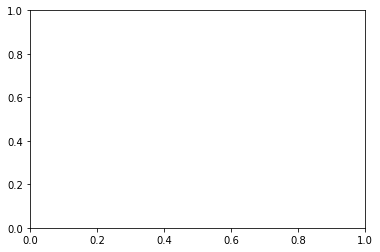
使用figsize参数设置绘图空间的宽和高
figsize = (width, height)
# Resize figure fig, ax = plt.subplots(figsize = (10, 6))
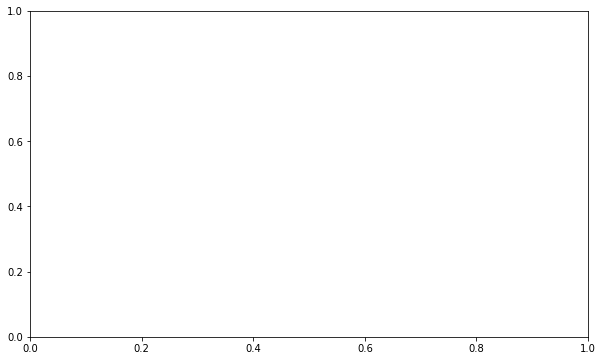
使用matplotlib的面向对象方法,通过创建额外的axis对象,可以更容易地在图空间中创建多个子图
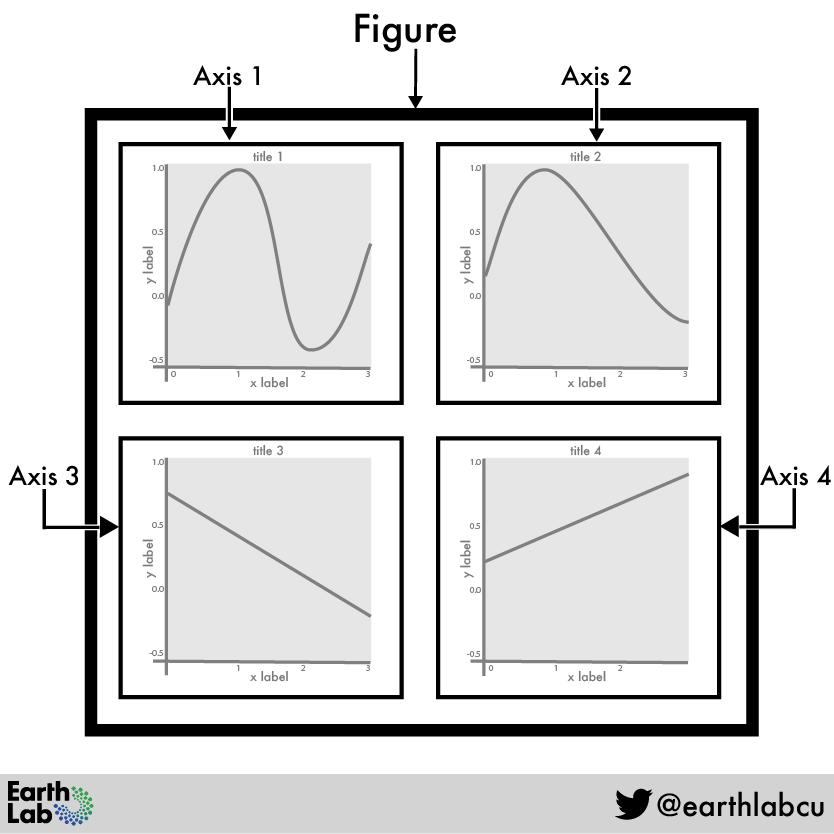
当添加多个axis对象时,最好的做法是给它们不同的名称(如ax1和ax2),这样就可以很容易地单独使用每个axis
因此,需要为plt.subplots提供新的参数,用于图的布局:(行数,列数)
plt.subplots(1, 2)
在本例中,1、2表示布局为1行,2列
# Figure with two plots fig, (ax1, ax2) = plt.subplots(1, 2, figsize = (10, 6))
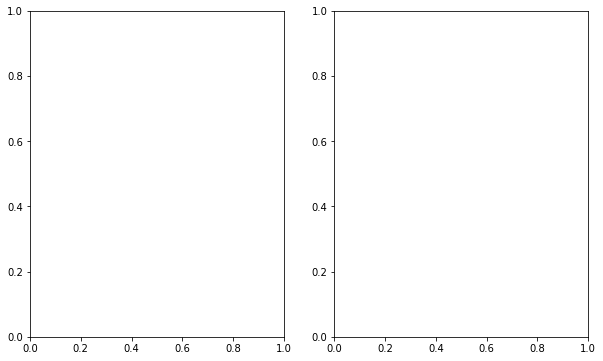
相反地,(2,1)表示2行,1列格局分布
fig, (ax1, ax2) = plt.subplots(2, 1, figsize = (10, 6))
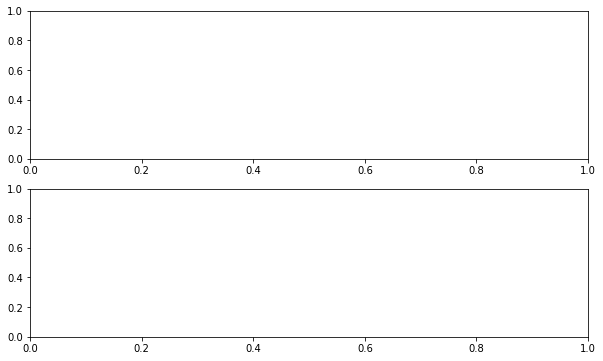
由于定义了figsize=(10,6),figure绘图空间会保持这个大小,无论如何设置行数或列数是多少
但是,可以调整行数、列数以及figsize,以得到需要的大小
# Figure with two plots fig, (ax1, ax2) = plt.subplots(2, 1, figsize = (12, 12))
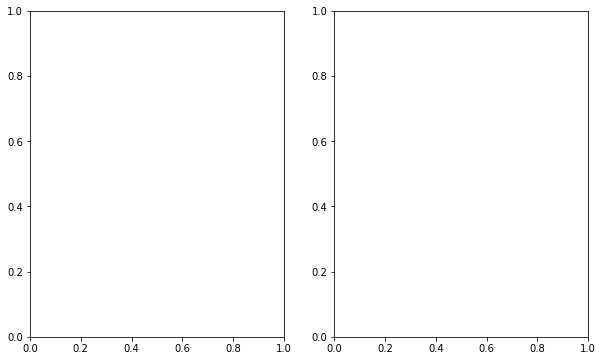
可以根据需要继续添加任意数量的axis对象,以创建所需图形的整体布局,并根据需要继续调整图形大小
# Figure with three plots fig, (ax1, ax2, ax3) = plt.subplots(3, 1, figsize = (15, 15))
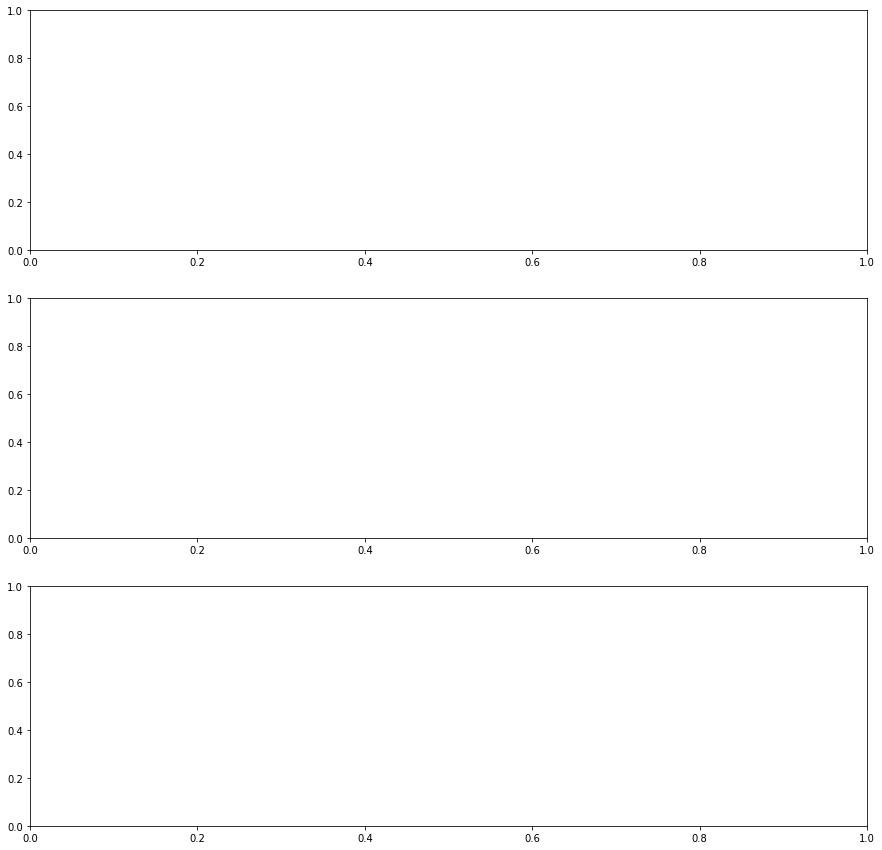
Matplotlib 面向对象方法的一个主要优点是,每个axis都是独立的的对象,可以独立于图中的其他绘图独立地进行自定义绘制
在本章的前面,学习了如何使用pyplot中的subplot ()函数创建图形和轴对象(使用别名plt导入) :
fig,ax = plt.subplots()
现在已经知道如何使用matplotlib创建基本的绘图,可以开始向图中的绘图添加数据了
首先导入别名plt的matplotlib.pyplot模块,并创建一些列表来绘制由美国国家海洋和大气管理局(NOAA)提供的*科罗拉多州博尔德市的月平均降水量(英寸)*
# Import pyplot 导入包 import matplotlib.pyplot as plt # Monthly average precipitation 月平均降水量 boulder_monthly_precip = [0.70, 0.75, 1.85, 2.93, 3.05, 2.02, 1.93, 1.62, 1.84, 1.31, 1.39, 0.84] # Month names for plotting 月份 months = ["Jan", "Feb", "Mar", "Apr", "May", "June", "July", "Aug", "Sept", "Oct", "Nov", "Dec"]
可以通过调用所需的ax对象将数据添加到绘图中,该对象是先前定义的axis元素:
fig,ax = plt.subplots()
通过调用ax对象的plot()方法,并指定绘图的x轴(水平轴)和y轴(垂直轴)的参数如下
plot(x_axis, y_axis)
在这个例子中,你正在从之前定义的列表中添加数据,数据沿着x轴和y轴分布
# Define plot space fig, ax = plt.subplots(figsize=(10, 6)) # Define x and y axes ax.plot(months, boulder_monthly_precip)
[<matplotlib.lines.Line2D at 0x7f0b21ed3e48>]
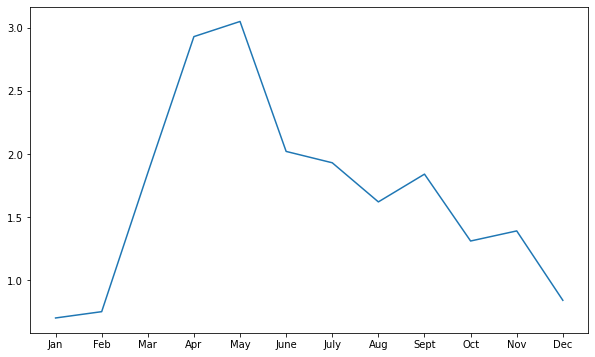
可以注意到,输出显示了图形的对象类型以及唯一标识符(内存位置)
[<matplotlib.lines.Line2D at 0x7f81afe900b8>]
可以通过在代码末尾调用plt.show()来隐藏该信息
# Define plot space fig, ax = plt.subplots(figsize=(10, 6)) # Define x and y axes ax.plot(months,boulder_monthly_precip) plt.show()
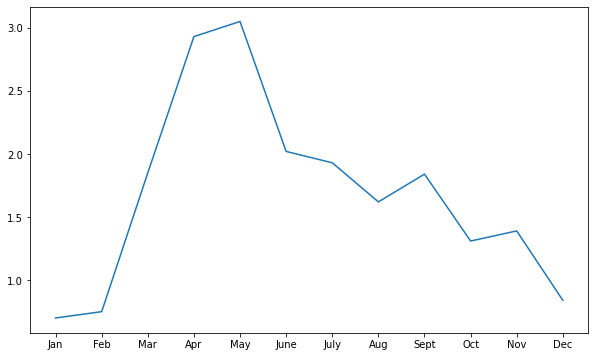
Python 社区中的惯例是使用ax来命名axis对象,但这并不是唯一的
# Define plot space with ax named bob fig, bob = plt.subplots(figsize=(10, 6)) # Define x and y axes bob.plot(months,boulder_monthly_precip) plt.show()
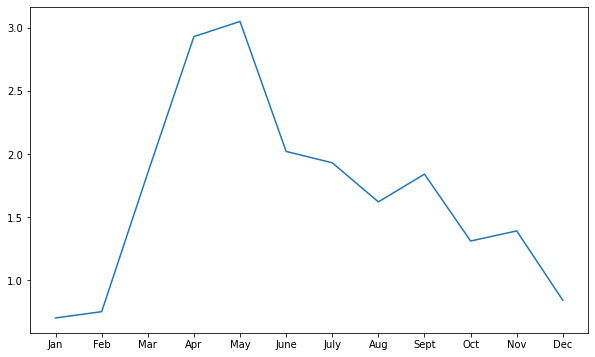
默认情况下,ax.plot 将绘图创建为线图(这意味着所有的值都通过横跨绘图的连续线连接起来)
可以使用 ax 对象来创建:
散点图(使用ax.scatter) : 值显示为不连续线的单个点
条形图(使用ax.bar) : 值显示为条形,其高度指示特定点的值
# Define plot space fig, ax = plt.subplots(figsize=(10, 6)) # Create scatter plot ax.scatter(months,boulder_monthly_precip) plt.show()
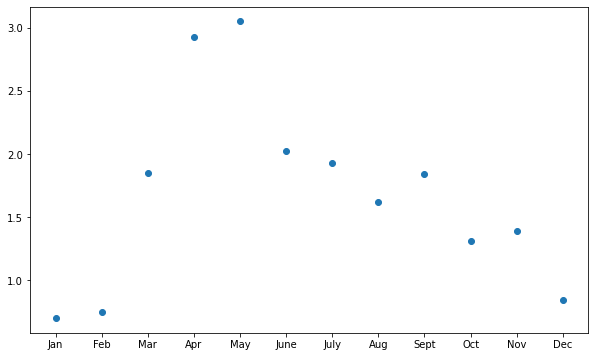
# Define plot space fig, ax = plt.subplots(figsize=(10, 6)) # Create bar plot ax.bar(months,boulder_monthly_precip) plt.show()
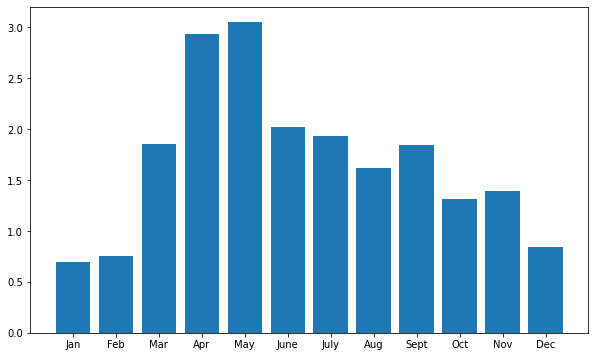
可以使用ax.set()方法中的title、xlabel、ylabel参数为轴添加绘图标题和标签,从而自定义和添加更多信息到绘图中
ax.set(title = "Plot title here", xlabel = "X axis label here", ylabel = "Y axis label here")
# Define plot space fig, ax = plt.subplots(figsize=(10, 6)) # Define x and y axes ax.plot(months, boulder_monthly_precip) # Set plot title and axes labels ax.set(title = "Average Monthly Precipitation in Boulder, CO", xlabel = "Month", ylabel = "Precipitation (inches)") plt.show()
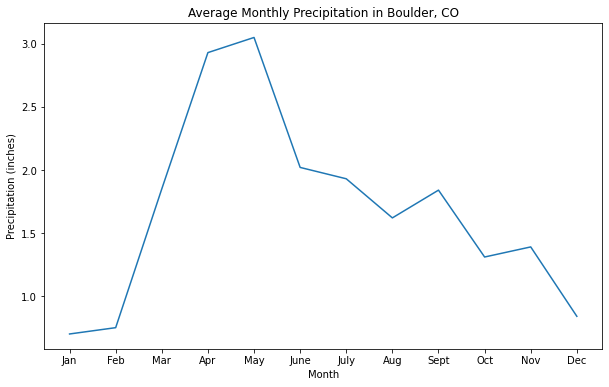
使用两个单词之间的新行字符**\n**创建具有多行文本的标题和轴标签
# Define plot space fig, ax = plt.subplots(figsize=(10, 6)) # Define x and y axes ax.plot(months, boulder_monthly_precip) # Set plot title and axes labels ax.set(title = "Average Monthly Precipitation\nBoulder, CO", xlabel = "Month", ylabel = "Precipitation\n(inches)") plt.show()
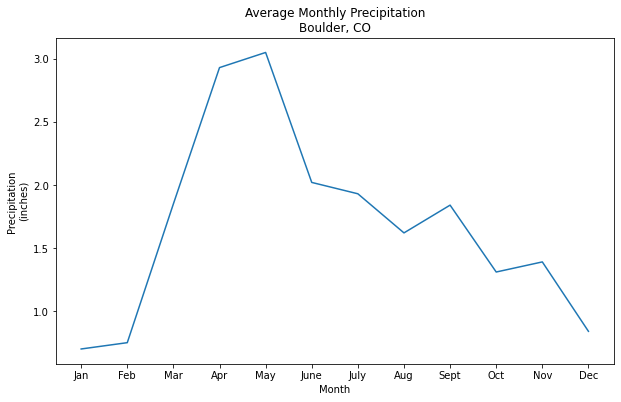
使用plt.setp函数设置整个绘图空间的参数,如自定义刻度标签
在下面的例子中,ax.get_xticklabels()函数控制x轴的刻度标签,rotation
# Define plot space fig, ax = plt.subplots(figsize=(10, 6)) # Define x and y axes ax.plot(months, boulder_monthly_precip) # Set plot title and axes labels ax.set(title = "Average Monthly Precipitation\nBoulder, CO", xlabel = "Month", ylabel = "Precipitation\n(inches)") plt.setp(ax.get_xticklabels(),rotation=45) plt.show()
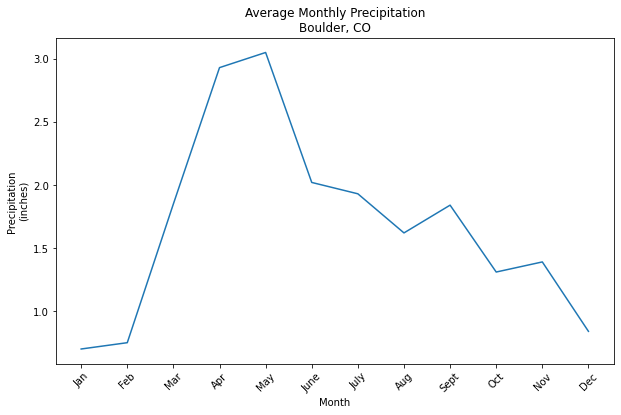
可以通过marker=参数对线段、点的形状标识进行修改
| Marker symbol | Marker description |
|---|---|
| . | point |
| , | pixel |
| o | circle |
| v | triangle_down |
| ^ | triangle_up |
| < | triangle_left |
| > | triangle_right |
访问Matplotlib文档可以获取更多标记类型列表
# Define plot space fig, ax = plt.subplots(figsize=(10, 6)) # Define x and y axes ax.scatter(months, boulder_monthly_precip, marker = ',') # pixel # Set plot title and axes labels ax.set(title = "Average Monthly Precipitation\nBoulder, CO", xlabel = "Month", ylabel = "Precipitation\n(inches)") plt.show()

# Define plot space fig, ax = plt.subplots(figsize=(10, 6)) # Define x and y axes ax.plot(months, boulder_monthly_precip, marker = 'o') # point # Set plot title and axes labels ax.set(title = "Average Monthly Precipitation\nBoulder, CO", xlabel = "Month", ylabel = "Precipitation\n(inches)") plt.show()
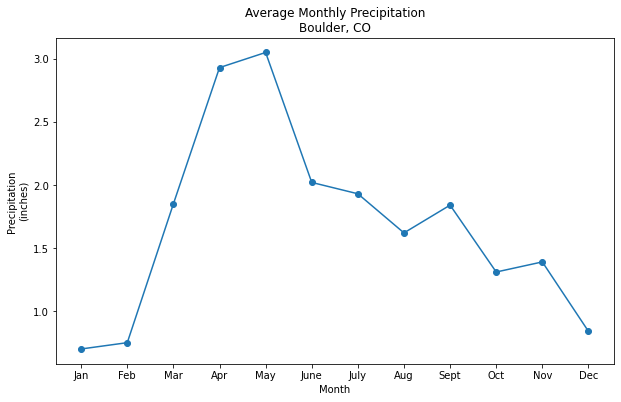
可以使用color参数自定义绘图颜色,在matplotlib中提供的一些基本颜色选项列表如下:
b: blue g: green r: red c: cyan m: magenta y: yellow k: black w: white
对于这些基本颜色,可以将color参数设置为等于全名(例如cyan)或者仅仅是如上表所示的键字母(例如c)
要获得更多的颜色,请访问关于颜色的matplotlib文档
# Define plot space fig, ax = plt.subplots(figsize=(10, 6)) # Define x and y axes ax.plot(months, boulder_monthly_precip, marker = 'o', color = 'cyan') # color=c # Set plot title and axes labels ax.set(title = "Average Monthly Precipitation\nBoulder, CO", xlabel = "Month", ylabel = "Precipitation\n(inches)") plt.show()
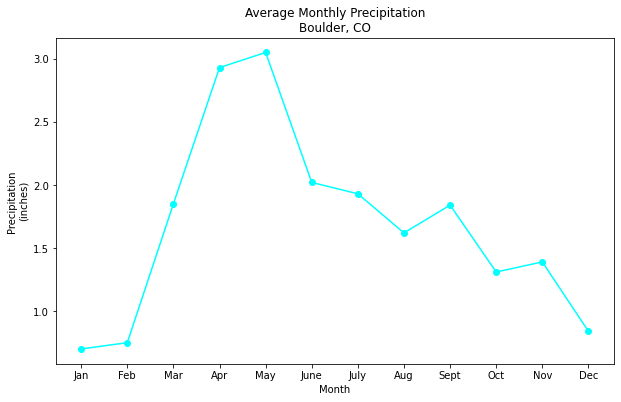
# Define plot space fig, ax = plt.subplots(figsize=(10, 6)) # Define x and y axes ax.scatter(months, boulder_monthly_precip, marker = ',', color = 'k') # color=black # Set plot title and axes labels ax.set(title = "Average Monthly Precipitation\nBoulder, CO", xlabel = "Month", ylabel = "Precipitation\n(inches)") plt.show()
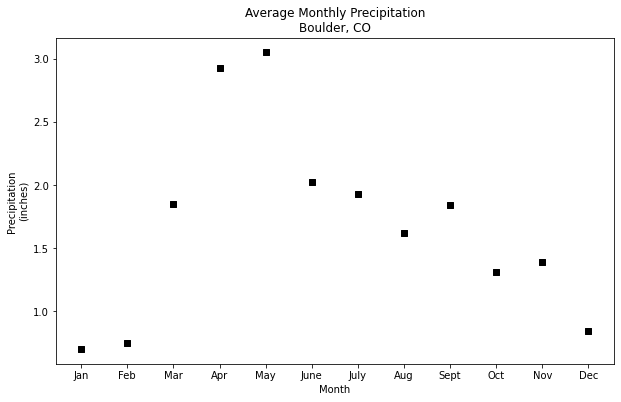
# Define plot space fig, ax = plt.subplots(figsize=(10, 6)) # Define x and y axes ax.bar(months, boulder_monthly_precip, color = 'darkblue') # Set plot title and axes labels ax.set(title = "Average Monthly Precipitation\nBoulder, CO", xlabel = "Month", ylabel = "Precipitation\n(inches)") plt.show()
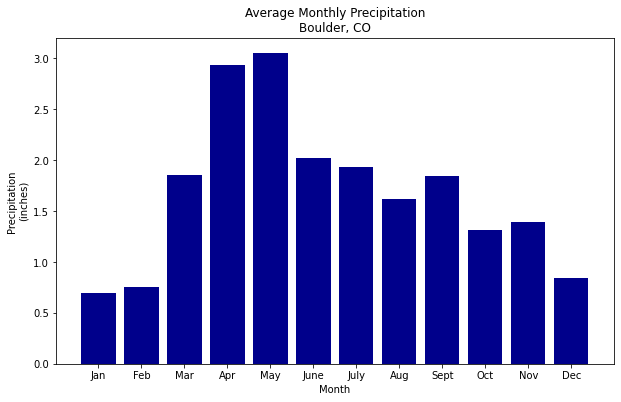
使用alpha =参数调整颜色的透明度,其值接近0.0表示更高的透明度
# Define plot space fig, ax = plt.subplots(figsize=(10, 6)) # Define x and y axes ax.bar(months, boulder_monthly_precip, color = 'darkblue', alpha = 0.3) # 透明度设置 # Set plot title and axes labels ax.set(title = "Average Monthly Precipitation\nBoulder, CO", xlabel = "Month", ylabel = "Precipitation\n(inches)") plt.show()

通过使用参数edgeccolor=将每个条的轮廓颜色更改为蓝色,并从前面讨论过的matplotlib颜色选项中指定一种颜色,可以进一步自定义条形图
# Define plot space fig, ax = plt.subplots(figsize=(10, 6)) # Define x and y axes ax.bar(months, boulder_monthly_precip, color = 'cyan', edgecolor = 'darkblue') # 轮廓颜色设置 # Set plot title and axes labels ax.set(title = "Average Monthly Precipitation\nBoulder, CO", xlabel = "Month", ylabel = "Precipitation\n(inches)") plt.show()
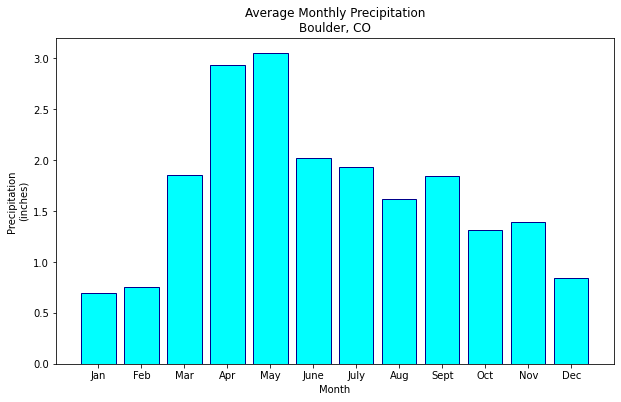
在使用散点图时,还可以使用c和cmap参数根据每个点的数据值为其分配一种颜色
c参数允许指定将被颜色映射的值序列(例如boulder _ monthly _ precip) ,而cmap允许指定用于该序列的颜色映射
下面的例子使用了YlGnBu颜色图,其中较低的值用黄色到绿色色调填充,而较高的值用越来越深的蓝色色调填充
要查看彩色地图选项列表,请访问的matplotlib cmpas文档
# Define plot space fig, ax = plt.subplots(figsize=(10, 6)) # Define x and y axes ax.scatter(months, boulder_monthly_precip, c = boulder_monthly_precip, cmap = 'YlGnBu') # Set plot title and axes labels ax.set(title = "Average Monthly Precipitation\nBoulder, CO", xlabel = "Month", ylabel = "Precipitation\n(inches)") plt.show()
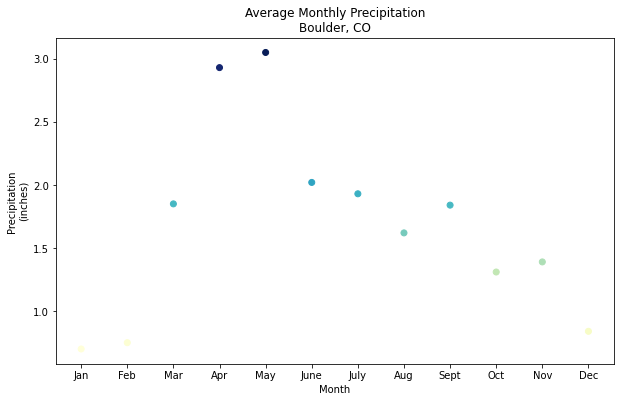
回想matplotlib的面向对象方法,通过创建额外的axis对象,可以很容易地在一个图形中包含多个图形:
fig, (ax1, ax2) = plt.subplots(num_rows, num_columns)
一旦定义了fig和两个axis对象,就可以向每个轴添加数据并定义具有独特特征的图形
在下面的示例中,ax1.bar在第一个绘图中创建一个定制的条形图,而ax2.scatter在第二个绘图中创建一个定制的散点图
# Define plot space fig, (ax1, ax2) = plt.subplots(2, 1, figsize=(12, 12)) # 两行一列 # Define x and y axes ax1.bar(months, boulder_monthly_precip, color = 'cyan', edgecolor = 'darkblue') # Define x and y axes ax2.scatter(months, boulder_monthly_precip, c = boulder_monthly_precip, cmap = 'YlGnBu') plt.show()
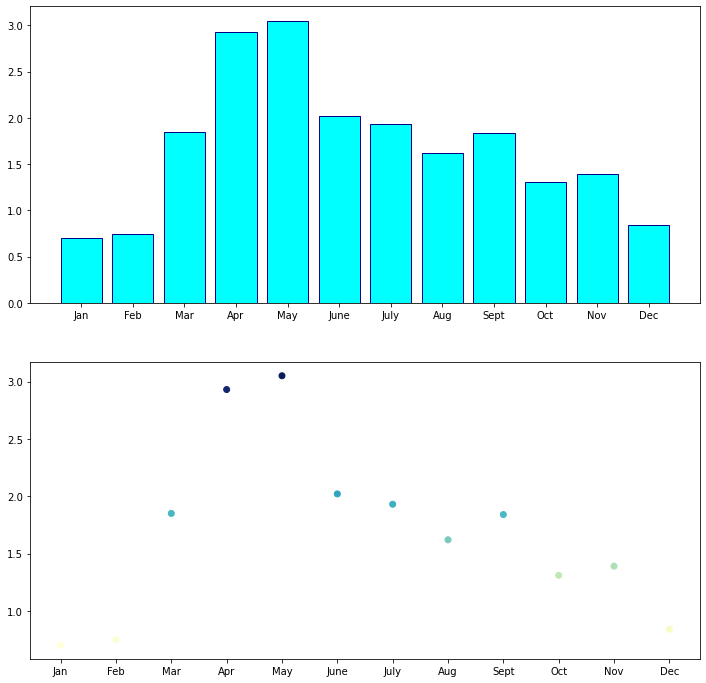
可以继续添加ax1和ax2,例如为每个单独的绘图添加标题和轴标签,就像您以前只有一个绘图时所做的那样
可以使用ax1.set()为第一个绘图(柱状图)定义元素,使用ax2.set()为第二个绘图(散点图)定义元素
# Define plot space fig, (ax1, ax2) = plt.subplots(2, 1, figsize=(12, 12)) # Define x and y axes ax1.bar(months, boulder_monthly_precip, color = 'cyan', edgecolor = 'darkblue') # Set plot title and axes labels ax1.set(title = "Bar Plot of Average Monthly Precipitation", xlabel = "Month", ylabel = "Precipitation\n(inches)"); # Define x and y axes ax2.scatter(months, boulder_monthly_precip, c = boulder_monthly_precip, cmap = 'YlGnBu') # Set plot title and axes labels ax2.set(title = "Scatter Plot of Average Monthly Precipitation", xlabel = "Month", ylabel = "Precipitation\n(inches)") plt.show()
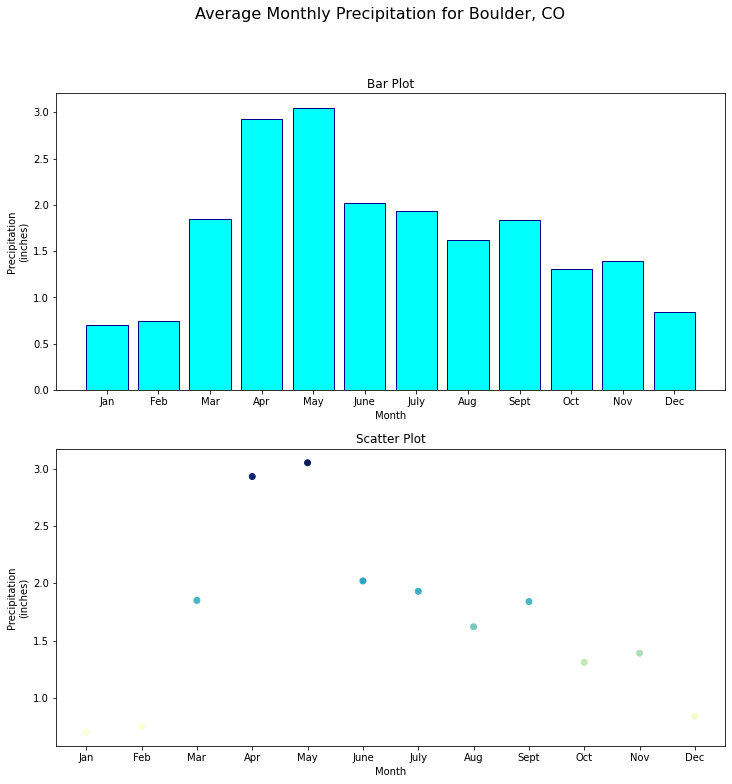
现在已经有了多个图形(每个图形都有自己的标签) ,还可以为整个图形添加一个总体标题(使用指定的字体大小) ,使用:
fig.suptitle("Title text", fontsize = 16)
# Define plot space
fig, (ax1, ax2) = plt.subplots(2, 1, figsize=(12, 12))
fig.suptitle("Average Monthly Precipitation for Boulder, CO", fontsize = 16)
# Define x and y axes
ax1.bar(months,
boulder_monthly_precip,
color = 'cyan',
edgecolor = 'darkblue')
# Set plot title and axes labels
ax1.set(title = "Bar Plot",
xlabel = "Month",
ylabel = "Precipitation\n(inches)");
# Define x and y axes
ax2.scatter(months,
boulder_monthly_precip,
c = boulder_monthly_precip,
cmap = 'YlGnBu')
# Set plot title and axes labels
ax2.set(title = "Scatter Plot",
xlabel = "Month",
ylabel = "Precipitation\n(inches)")
plt.show()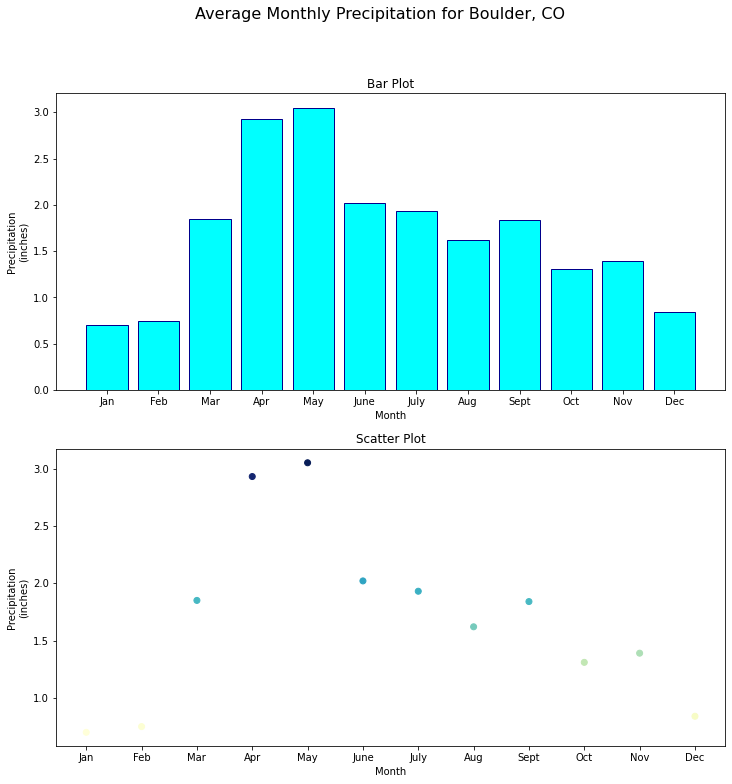
可以使用以下命令轻松地将图形保存到图像文件中,例如 .png:
plt.savefig ("path/name-of-file.png")
可以保存最新的数据,如果没有为文件指定一个路径,文件将会在你当前的工作目录文件夹中创建
查看Matplotlib文档以查看用于保存图形的其他文件格式的列表
# Define plot space
fig, (ax1, ax2) = plt.subplots(2, 1, figsize=(12, 12))
fig.suptitle("Average Monthly Precipitation for Boulder, CO", fontsize = 16)
# Define x and y axes
ax1.bar(months,
boulder_monthly_precip,
color = 'cyan',
edgecolor = 'darkblue')
# Set plot title and axes labels
ax1.set(title = "Bar Plot",
xlabel = "Month",
ylabel = "Precipitation\n(inches)");
# Define x and y axes
ax2.scatter(months,
boulder_monthly_precip,
c = boulder_monthly_precip,
cmap = 'YlGnBu')
# Set plot title and axes labels
ax2.set(title = "Scatter Plot",
xlabel = "Month",
ylabel = "Precipitation\n(inches)")
plt.savefig("output/average-monthly-precip-boulder-co.png")
plt.show()关于颜色条的更多信息color bars
深入介绍matplotlib
# Import required python packages
import os
import pandas as pd
import matplotlib.pyplot as plt
from matplotlib.dates import DateFormatter
import matplotlib.dates as mdates
import seaborn as sns
import earthpy as et
# Date time conversion registration
from pandas.plotting import register_matplotlib_converters
register_matplotlib_converters()
# Get the data
# data = et.data.get_data('colorado-flood')
# Set working directory
os.chdir(os.path.join(et.io.HOME, 'learning','python_data_plot'))
# Prettier plotting with seaborn
sns.set(font_scale=1.5)
sns.set_style("whitegrid")在本节中,将学习如何在Python中使用matplotlib绘制时间序列
# Read in the data data_path = "data/precipitation/805325-precip-dailysum-2003-2013.csv" boulder_daily_precip = pd.read_csv(data_path, parse_dates=['DATE'], # 将csv中的时间字符串转换成日期格式 na_values=['999.99'], index_col=['DATE'])
boulder_daily_precip.head()
<div> <style scoped> .dataframe tbody tr th:only-of-type { vertical-align: middle; }
.dataframe tbody tr th {
vertical-align: top;
}
.dataframe thead th {
text-align: right;
}</style> <table border="1" class="dataframe"> <thead> <tr > <th></th> <th>DAILY_PRECIP</th> <th>STATION</th> <th>STATION_NAME</th> <th>ELEVATION</th> <th>LATITUDE</th> <th>LONGITUDE</th> <th>YEAR</th> <th>JULIAN</th> </tr> <tr> <th>DATE</th> <th></th> <th></th> <th></th> <th></th> <th></th> <th></th> <th></th> <th></th> </tr> </thead> <tbody> <tr> <th>2003-01-01</th> <td>0.0</td> <td>COOP:050843</td> <td>BOULDER 2 CO US</td> <td>1650.5</td> <td>40.03389</td> <td>-105.28111</td> <td>2003</td> <td>1</td> </tr> <tr> <th>2003-01-05</th> <td>NaN</td> <td>COOP:050843</td> <td>BOULDER 2 CO US</td> <td>1650.5</td> <td>40.03389</td> <td>-105.28111</td> <td>2003</td> <td>5</td> </tr> <tr> <th>2003-02-01</th> <td>0.0</td> <td>COOP:050843</td> <td>BOULDER 2 CO US</td> <td>1650.5</td> <td>40.03389</td> <td>-105.28111</td> <td>2003</td> <td>32</td> </tr> <tr> <th>2003-02-02</th> <td>NaN</td> <td>COOP:050843</td> <td>BOULDER 2 CO US</td> <td>1650.5</td> <td>40.03389</td> <td>-105.28111</td> <td>2003</td> <td>33</td> </tr> <tr> <th>2003-02-03</th> <td>0.4</td> <td>COOP:050843</td> <td>BOULDER 2 CO US</td> <td>1650.5</td> <td>40.03389</td> <td>-105.28111</td> <td>2003</td> <td>34</td> </tr> </tbody> </table> </div>
# Subset the data # 提取8月15至10月15之间的数据 precip_boulder_AugOct = boulder_daily_precip["2013-08-15":"2013-10-15"] # View first few rows of data precip_boulder_AugOct.head()
<div> <style scoped> .dataframe tbody tr th:only-of-type { vertical-align: middle; }
.dataframe tbody tr th {
vertical-align: top;
}
.dataframe thead th {
text-align: right;
}</style> <table border="1" class="dataframe"> <thead> <tr > <th></th> <th>DAILY_PRECIP</th> <th>STATION</th> <th>STATION_NAME</th> <th>ELEVATION</th> <th>LATITUDE</th> <th>LONGITUDE</th> <th>YEAR</th> <th>JULIAN</th> </tr> <tr> <th>DATE</th> <th></th> <th></th> <th></th> <th></th> <th></th> <th></th> <th></th> <th></th> </tr> </thead> <tbody> <tr> <th>2013-08-21</th> <td>0.1</td> <td>COOP:050843</td> <td>BOULDER 2 CO US</td> <td>1650.5</td> <td>40.0338</td> <td>-105.2811</td> <td>2013</td> <td>233</td> </tr> <tr> <th>2013-08-26</th> <td>0.1</td> <td>COOP:050843</td> <td>BOULDER 2 CO US</td> <td>1650.5</td> <td>40.0338</td> <td>-105.2811</td> <td>2013</td> <td>238</td> </tr> <tr> <th>2013-08-27</th> <td>0.1</td> <td>COOP:050843</td> <td>BOULDER 2 CO US</td> <td>1650.5</td> <td>40.0338</td> <td>-105.2811</td> <td>2013</td> <td>239</td> </tr> <tr> <th>2013-09-01</th> <td>0.0</td> <td>COOP:050843</td> <td>BOULDER 2 CO US</td> <td>1650.5</td> <td>40.0338</td> <td>-105.2811</td> <td>2013</td> <td>244</td> </tr> <tr> <th>2013-09-09</th> <td>0.1</td> <td>COOP:050843</td> <td>BOULDER 2 CO US</td> <td>1650.5</td> <td>40.0338</td> <td>-105.2811</td> <td>2013</td> <td>252</td> </tr> </tbody> </table> </div>
fig, ax = plt.subplots(figsize=(12, 8))
ax.plot(precip_boulder_AugOct.index.values,
precip_boulder_AugOct['DAILY_PRECIP'].values,
'-o',
color='purple')
ax.set(xlabel="Date", ylabel="Precipitation (Inches)",
title="Daily Precipitation \nBoulder, Colorado 2013")
# Format the x axis
# 对x轴进行日期格式化
ax.xaxis.set_major_locator(mdates.WeekdayLocator(interval=2))
ax.xaxis.set_major_formatter(DateFormatter("%m-%d"))
plt.show()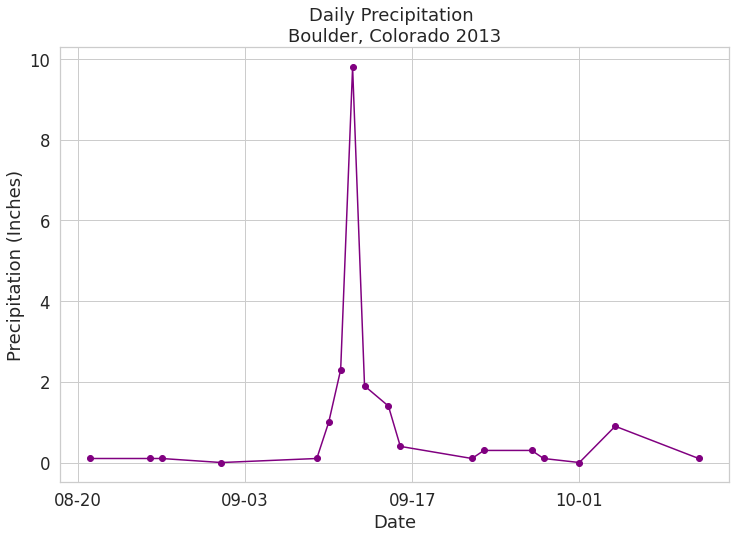
在 matplotlib 中,也可以使用 DateFormatter 模块更改绘图轴上的日期格式
需要从 matplotlib 导入 DateFormatter,然后使用以下语法指定日期 DateFormatter 要使用的格式:
%Y-4位数年份 %y-2位数年份 %m-月份 %d-天
实现自定义日期的步骤:
定义日期格式: myFmt = DateFormatter("%m/%d"),这个日期格式是月/日,所以它看起来像这样: 10/05,代表10月5日
调用set_major_formatter()方法:
ax.xaxis.set_major_formatter(myFmt)
将上面定义的日期格式应用于绘图空间中
# Plot the data
fig, ax = plt.subplots(figsize=(10,6))
ax.scatter(precip_boulder_AugOct.index.values,
precip_boulder_AugOct['DAILY_PRECIP'].values,
color='purple')
ax.set(xlabel="Date", ylabel="Precipitation (Inches)",
title="Daily Precipitation (inches)\nBoulder, Colorado 2013")
# Define the date format
date_form = DateFormatter("%m/%d")
ax.xaxis.set_major_formatter(date_form)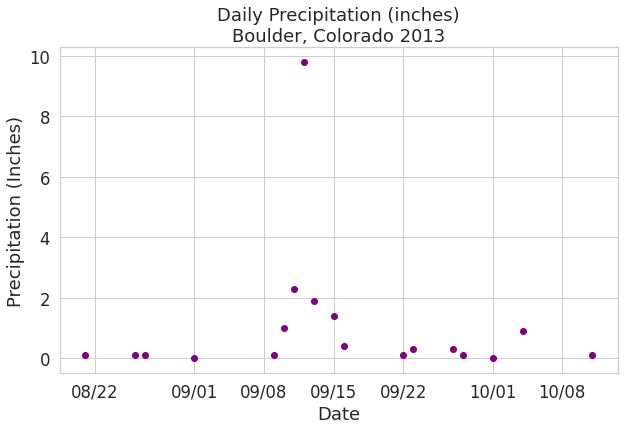
特定的时间刻度可以沿着x轴添加,例如:大的刻度可以表示每个新的工作周的开始,小的刻度可以表示每个工作日
函数xaxis.set_major_locator()控制大刻度的位置,函数xaxis.set_minor_locator控制小刻度
# Plot the data
fig, ax = plt.subplots(figsize=(10,6))
ax.scatter(precip_boulder_AugOct.index.values,
precip_boulder_AugOct['DAILY_PRECIP'].values,
color='purple')
ax.set(xlabel="Date", ylabel="Precipitation (Inches)",
title="Daily Precipitation (inches)\nBoulder, Colorado 2013")
# 定义日期格式
date_form = DateFormatter("%m/%d")
ax.xaxis.set_major_formatter(date_form)
# 确保每隔一周刻度减小一次
ax.xaxis.set_major_locator(mdates.WeekdayLocator(interval=1))
# ax.xaxis.set_minor_locator(mdates.DayLocator(1))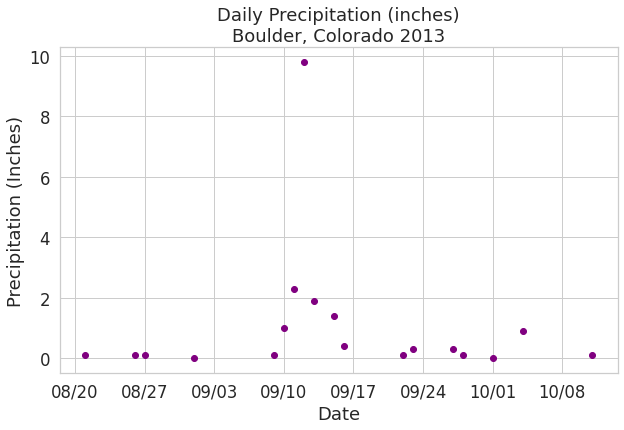
到此,相信大家对“Python中怎么使用Matplotlib绘制统计图”有了更深的了解,不妨来实际操作一番吧!这里是亿速云网站,更多相关内容可以进入相关频道进行查询,关注我们,继续学习!
免责声明:本站发布的内容(图片、视频和文字)以原创、转载和分享为主,文章观点不代表本网站立场,如果涉及侵权请联系站长邮箱:is@yisu.com进行举报,并提供相关证据,一经查实,将立刻删除涉嫌侵权内容。